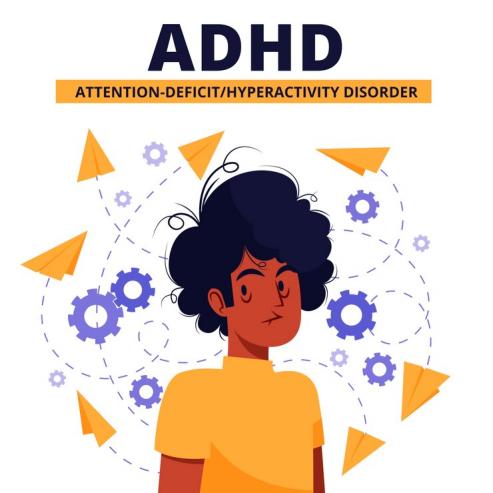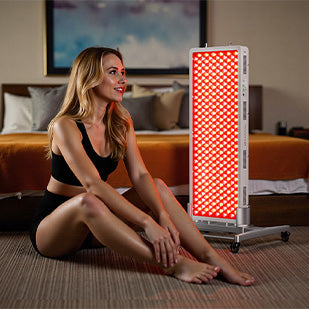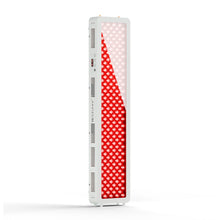According to some recent studies, 1 in 9 American kids has ever received an attention-deficit and hyperactivity disorder (ADHD) diagnosis, and around 10,5% of all children from the USA are currently struggling with hyperactivity symptoms. Also, data from the National Institute of Mental Health reports that about 4,4% of all adults have a severe ADHD.
Most people with ADHD take medications to overcome negative symptoms. But are there any alternatives? In this article, we will discuss the potential benefits of red light therapy for people with ADHD.

What is Red Light Therapy and How Does It Work?
Currently, medical scientists do not come to a general conclusion regarding the causes of ADHD. So, for now, there is no practical way to prevent and treat the leading cause of this disorder. Yet, many recent studies show a positive impact of light therapy in adults struggling with ADHD [1]. To better understand the potential effect of red light therapy in people with attention-deficit and hyperactivity disorder, we must learn how RLT works on a cellular level and how it impacts brain tissue.
How Red Light Therapy Works at a Cellular Level
Speaking in a few simple words, red light therapy helps to improve the working efficiency of those cells that absorb some light with specific wavelengths. The main effect of RLT on the human organism is called photobiomodulation. Yet, it’s not the only process that launches inside cells during the red light therapy sessions.
Briefly speaking, RLT helps to launch a renewal process inside cells, forcing cells to produce more energy and stimulate cell metabolism when applied to the skin's surface. Other effects of red light therapy include, but are not limited to, decreasing the blood glucose level [2], stimulating hair growth, and improving skin condition.
Key Benefits of Red Light Therapy for Brain Health
Photobiomodulation, occurring during red light therapy, helps the nervous system work more effectively, increases the brain blood flow, and leads to numerous antioxidant and anti-inflammatory effects. Brain cells also begin to develop more ATP (the primary energy source on a cellular level) [3], which naturally increases the efficiency of metabolism and improves the cognitive functions of the whole nervous system.

The Theoretical Potential: How Might RLT Interact with Brain Function Relevant to ADHD?
The human brain is a complex organ, and scientists are continuing to discover more unexpected information about its functions every day. For now, there is no direct evidence that ADHD is directly linked with any significant diseases or conditions of the patient's brain. As a result, it’s pretty hard to discover a cure for this disorder. Yet, modern medicine can help patients manage ADHD symptoms. And red light therapy might become one of the methods of your choice.
Red Light Therapy Works to Improve Brain Health
RLT is proven to increase the production of ATP in the mitochondria inside all cells of the human organism. ATP is a molecule that is the primary source of energy for all metabolic processes occurring inside the body, including the nervous system. So, regular red light therapy sessions provide the patient’s brain with a sufficient amount of ATP, gradually improving its cognitive functions.
Studies show that regular low-level red light therapy has a positive impact on red blood cells and general blood flow [4]. So, the whole nervous system, including the brain cells, receives a sufficient amount of nutrients and oxygen, which helps them to work correctly. As a result, the patient’s brain starts to work much better and gains an additional stability against various negative factors, including oxidative stress and cellular inflammation.
Red Light Therapy vs. Common ADHD Medications
Traditional ADHD treatment mainly consists of various medications and psychotherapy. Both methods can help to manage symptoms, but they can’t cure the disorder. Moreover, such traditional medicines for patients with ADHD, such as stimulants, can cause addiction and other severe adverse effects [5]. On the contrary, red light therapy has no significant side effects when used according to the modern treatment protocols.
What Does Research Say About Red Light Therapy for ADHD?
Nowadays, there are not very many clinical studies that confirm the efficiency of red light therapy for patients with ADHD. Yet, in 2022, World Journal of Neuroscience published an article of three case studies that confirm the positive impact of red light therapy on patients who struggle with hyperactivity symptoms [6]. Based on that paper, RLT might have become a proven method for ADHD management in recent years.
Summary of Existing Studies
Lots of studies show that red light therapy might help to improve the patient's bad mood and cope with depression [7], which also often becomes a problem for patients with ADHD. Other studies report that red and near-infrared LED therapy can significantly enhance cognition in patients with brain injury and other chronic conditions. Last but not least, 600 to 1100 nm wavelength light stimulates healing, protects tissue from dying, increases mitochondrial function, improves blood flow, and tissue oxygenation [8]. The whole range of mentioned effects will have an excellent impact on people struggling with ADHD.
Limitations and Gaps in Existing Research
Since scientists have not currently come to a unified conclusion regarding the leading cause of ADHD, it’s hard to measure how different treatment methods impact the patient's condition. In addition, ADHD includes a wide range of different symptoms, and it’s often pretty much impossible to trace the impact of different treatments in various patients. More likely, as soon as we find out more about the etiology (exact causes) of ADHD, the existing treatment methods will significantly improve.
How to Use Red Light Therapy Safely
Since the time we were in elementary school, we all learned the importance of one essential rule. This rule is: safety first. Using red light therapy when you have ADHD might be challenging due to the condition’s specific symptoms. That’s why we’d like to remind you about a few crucial moments.
Use Optimal Wavelengths, Dosage, and Session Frequency
Remember that the effects of red light therapy have a cumulative nature. You should always stick to your treatment protocol, use a proper wavelength, and get an RLT session according to a personal schedule. Both insufficient and excessive use of red light therapy devices can lead to a complete lack of results, poor effects, or other negative outcomes.
Safety Considerations for Children and Adults
People with ADHD tend to be pretty much impulsive, often lose track of time, and even completely forget that they are currently using a red light therapy device. So, we recommend that you use a timer or other methods that will help to remind you about the end of the treatment session. When kids use the RLT device, their parents' control is strictly advised.
Red Light Therapy Is Not a Replacement for Traditional ADHD Treatments
Remember that RLT devices are only a complementary tool that might help people manage their ADHD symptoms more effectively. Always stick to the treatment methods prescribed by your doctor, and remember that red light therapy isn’t a replacement for medications and psychotherapy. RLT might help you to cope with some symptoms more effectively, but it’s definitely not a panacea against ADHD.
The Future of Red Light Therapy in ADHD Care
As medical science gradually improves, we will see the development of new treatment protocols and recommendations for managing ADHD, which include red light therapy as a crucial component.
Emerging Trends and Innovations in Photobiomodulation
After obtaining strong proof that LED red light therapy is efficacious in improving the overall condition of the superficial cells, scientists decided to try to create light and laser devices to stimulate various cells inside the human body. In a study conducted in 2025, they started to gather evidence of effectiveness and develop implants for photobiomodulation therapy [9]. LED and laser implants remain among the most innovative trends in the photobiomodulation industry.
Why Personalized Approaches Matter in ADHD Management
As we already mentioned, different patients with ADHD might have varying sets of symptoms. Some patients might have panic attacks and anxiety, while others will struggle with comorbid depression. Naturally, different patients will need varying treatment methods to cope with their symptoms. As a result, a personalized approach is the key to developing the most suitable disorder management strategy.
References:
- Rybak YE, McNeely HE, Mackenzie BE, Jain UR, Levitan RD. An open trial of light therapy in adult attention-deficit/hyperactivity disorder. J Clin Psychiatry. 2006 Oct;67(10):1527-35. doi: 10.4088/jcp.v67n1006. PMID: 17107243.
- Powner MB, Jeffery G. Light stimulation of mitochondria reduces blood glucose levels. J Biophotonics. 2024 May;17(5):e202300521. doi: 10.1002/jbio.202300521. Epub 2024 Feb 20. PMID: 38378043.
- Kaffash Z, Saha R, Mirbozorgi SA, Faezipour M, Mirbozorgi SA. Photobiomodulation Therapy; Survey and Principal Study Leading to Design Rules for Implants. IEEE Trans Biomed Eng. 2025 Feb 4; PP. doi: 10.1109/TBME.2025.3538650. Epub ahead of print. PMID: 40031731.
- Walski T, Drohomirecka A, Bujok J, Czerski A, Wąż G, Trochanowska-Pauk N, Gorczykowski M, Cichoń R, Komorowska M. Low-Level Light Therapy Protects Red Blood Cells Against Oxidative Stress and Hemolysis During Extracorporeal Circulation. Front Physiol. 2018 May 31;9:647. doi: 10.3389/fphys.2018.00647. PMID: 29904353; PMCID: PMC5991292.
- Groom MJ, Cortese S. Current Pharmacological Treatments for ADHD. Curr Top Behav Neurosci. 2022;57:19-50. doi: 10.1007/7854_2022_330. PMID: 35507282.
- Stephan, W., Banas, L., Brierley, W. and Hamblin, M. (2022) Efficacy of Photobiomodulation for Attention Deficit Hyperactivity Disorder (ADHD): Case Studies. World Journal of Neuroscience, 12, 136-143. doi:10.4236/wjns.2022.123015.
- Reeves GM, Nijjar GV, Langenberg P, Johnson MA, Khabazghazvini B, Sleemi A, Vaswani D, Lapidus M, Manalai P, Tariq M, Acharya M, Cabassa J, Snitker S, Postolache TT. Improvement in depression scores after 1 hour of light therapy treatment in patients with seasonal affective disorder. J Nerv Ment Dis. 2012 Jan;200(1):51-5. doi: 10.1097/NMD.0b013e31823e56ca. PMID: 22210362; PMCID: PMC5336550.
- Hamblin MR. Photobiomodulation for traumatic brain injury and stroke. J Neurosci Res. 2018 Apr;96(4):731-743. doi: 10.1002/jnr.24190. Epub 2017 Nov 13. Erratum in: J Neurosci Res. 2019 Mar;97(3):373. doi: 10.1002/jnr.24376. PMID: 29131369; PMCID: PMC5803455.
- Kaffash Z, Saha R, Mirbozorgi SA, Faezipour M, Mirbozorgi SA. Photobiomodulation Therapy: Survey and Principal Study Leading to Design Rules for Implants. IEEE Trans Biomed Eng. 2025 Feb 4; PP. doi: 10.1109/TBME.2025.3538650. Epub ahead of print. PMID: 40031731.















 Small
Small

 Moderate
Moderate

 Moderate
Moderate

 Moderate
Moderate

 Full
Full



